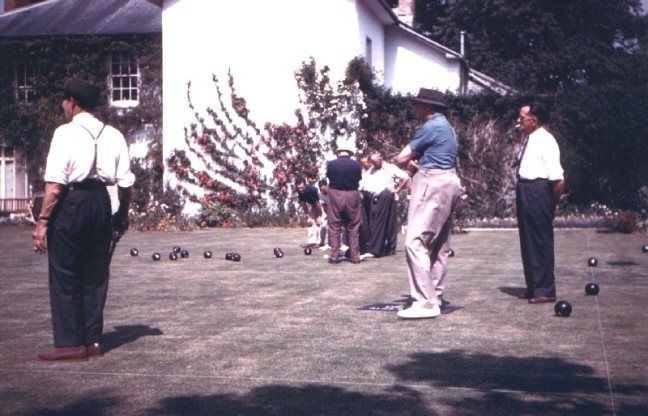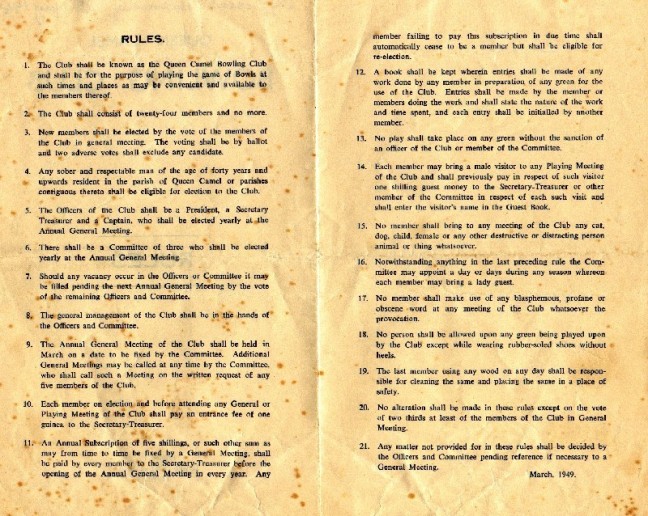1948 to 2002
A BRIEF HISTORY OF QUEEN CAMEL BOWLS CLUB
The imposing,upright gentleman who frequently wore a labourer’s smock when he walked around his home village of Queen Camel, was a highly respected circuit judge by the name of Arthur Henry Armstrong. He would also carry a six foot staff with a `y’ fork at the top and have a trug of garden produce hanging on his arm from which he would offer to give items to the villagers.
On the 17th. September 1948 this gentleman gathered a group of eight other interested men together to discuss the possibility of forming a bowls club. They were the Rev.P C Bush, messrs.E Brooks, B Owens, F Reeves, R Soper, K Gare, F Brooks and T Elliston. His suggestion was well received and a steering committee of five was set up with the Rev.Bush as president, Mr Elliston as secretary/treasurer and His Honour Judge Armstrong, Mr E Brooks and Mr K Gare as committee members.

Two sets of woods were purchased by Judge Armstrong for £23 17s, with a mat and a jack being thrown in. Two rinks were set up on the judge’s lawn as no other green was available.They had a motor mower but no petrol so an application was made to the ministry of fuel and power, and an allocation of two gallons was received in June of 1949. While it being very pleasant in the Judge’s garden, the huge root of a nearby fir tree made the bowls deviate at alarming angles and if the jack was driven hard it could mount the four inch bank and disappear into the goldfish pond, a few yards further on!

At the second meeting seven new members were welcomed, among them a Dr.John Barlow who became the club’s first captain for the `49 season. By the end of that year the club showed a financial deficit of 9s. 8d, so each member was asked to contribute one shilling in order that the following season could start with a small balance.To put the finances on a sounder footing for 1950 a refreshment fund of one shilling per member per game was started.
The rules at that time stated that membership was open to `any sober and respectable man of the age of forty years and upwards, resident in the parish of Queen Camel. ‘ This minimum age limit was imposed to prevent younger,more athletic men being attracted away from the village cricket team. The fee to join the bowls club was one guinea, the annual subscription five shillings and the maximum number of members was set at twenty.
Over shoes were purchased which could be hired by players at threepence a time.
Another rule was that `no member shall bring to any meeting of the club any cat, dog, child, female or any other destructive or distracting person, animal or thing whatsoever. ‘
However the club prospered, no doubt helped by the strawberry and cream teas provided by His Honour, and in the course of the next few years fixtures with other clubs increased, club competitions were organised, and in 1953 the club voted to become affiliated to the SCBA. In spite of the rule about distracting influences, a ladies day and an annual dinner were introduced into the calendar.

Judge Armstrong was elected club president in 1951, and remained in that post until he died in 1972. He lived in the old vicarage and it was his expressed wish that a portion of the glebe land be used by the bowls club as a permanent home for their green, pavilion and car park. The legalities had not been completed at the time of his death but the executors of his will agreed that his wish be fulfilled so they appointed a board of trustees consisting of the Rector and Churchwardens of the church of St Barnabas, together with the chairman of the parish council.This trust would act as landlords with the bowls club as tenants & be paid such rent as would meet their administrative costs. £1 has been paid annually to the trustees on the 1st May ever since.
Should the rent not be paid or the club cease to exist, the trustees would convey the land to the parochial church council to be used for the benefit of the inhabitants of the village.
Granted the use of the land, the then members set about raising money to level and lay a green and later to build a pavilion. With a grant from the sports council a green was constructed and for a year or two the pavilion on the adjoining playing field was used as a changing room. Then with fund raising activities, gifts and loans ranging from £5 to £500 from members, and a loan of £1000 from the Somerset Playing Fields Association, a pavilion was purchased, erected and proudly opened on the 7th. August 1976.Since then, on four more occasions, funds have been raised and grants obtained to enlarge and extend the pavilion. Firstly the front wall was moved forward to enclose the verandah; then the gents changing room was built on at the south end. Next,in 1992,with a grant of £6000 from South Somerset DC, an extension to house the ladies changing room, the bar and ladies and gents toilets was added. In 1998 the kitchen was enlarged and modernised, the ladies changing area enlarged, and an equipment store and disabled toilet added. With the purchase of a wheelchair the cost of that project was £20,000, which was met with grants of £12, 000 from the lottery via the English Sports Council, £2,000 from South Somerset District Council, and £6,000 from club funds. In all these projects a considerable amount of self help in the form of building, carpentry, painting and decorating, electrical wiring, plumbing etc.has come from the members themselves.
In 1998 a grand opening of the final extension was organised as it coincided with the club’s fiftieth anniversary. On May 16th, a beautiful summer’s day, representatives from the SCBA, The Lottery Fund, The English Sports Council, South Somerset District Council, the trustees, Judge Armstrong’s daughter and grandson, and many members and friends attended. The opening ceremony was performed by the Honourable David Heath CBE, MP for East Somerset. To celebrate the club’s jubilee a specially recreated version of the Judge’s lawn was constructed on two rinks, including a temporary sixteen foot fish pond, trees and shrubs. Eight founder members re-lived their earlier days by playing a game under the old conditions!
Since the early days fencing panels have been erected on three sides of the site, ditches, banks and surrounding areas have been improved, a concrete entrance drive laid and an automatic watering system installed. Site, green and pavilion maintenance have always been done by volunteers from the membership using the club’s own equipment. An active social programme helps the clubs funds. Today ladies form about a third of the total membership, which hovers around the one hundred mark, and now includes players from surrounding villages and as far away as Yeovil, Bradford Abbas and Castle Cary.Each season the club plays in the Wessex mixed friendly league and hosts games against touring teams, men’s and ladies county matches and the county patrons. It puts on an open triples tournament and a ladies bowls drive. With the ladies league and friendly fixtures, a total of about ninety games are played; not bad for a small village club with such humble beginnings,and which is still honoured to have the grandson of Judge Armstrong as a life member.
Footnote.
Sometimes visiting teams,especially if from outside somerset, ask about the rather unusual name Queen Camel. Unfortunately there is no clear explanation as the origins have been lost in the mists of time & the following offerings can be no more than intelligent guesses.
It seems likely that the low lying ridge, along which runs the A303 just north of the village, gives the village its name. A reference in the archives at Muchelney Abbey (some ten miles to the west),records the village as cantmael. `cant’ & `cam’ are ancient words for ridge or hill and `mael’ means bare. Today the ridge is known as Camel Hill.
The `queen’ part could possibly come from Edward 1st second wife who was granted the manor by her husband. It could be that the village became known as Queen’s Cantmael or Queen’s Camael which would have been its name in the early part of the 14th century.
Previous to that the village was known as East Camel, and West Camel still exists with its name unchanged.The Domesday survey in 1086 noted two mills at Camel. Assuming the mills took their power from the river cam which flows through both villages, perhaps the names have evolved from East Cam mill & West Cam mill. What is sure is that camels as such, have no part in the club’s history!
Taken from ‘Queen Camel,our royal heritage’ by Gordon Moore,first published 1983.
KEN DAVY

